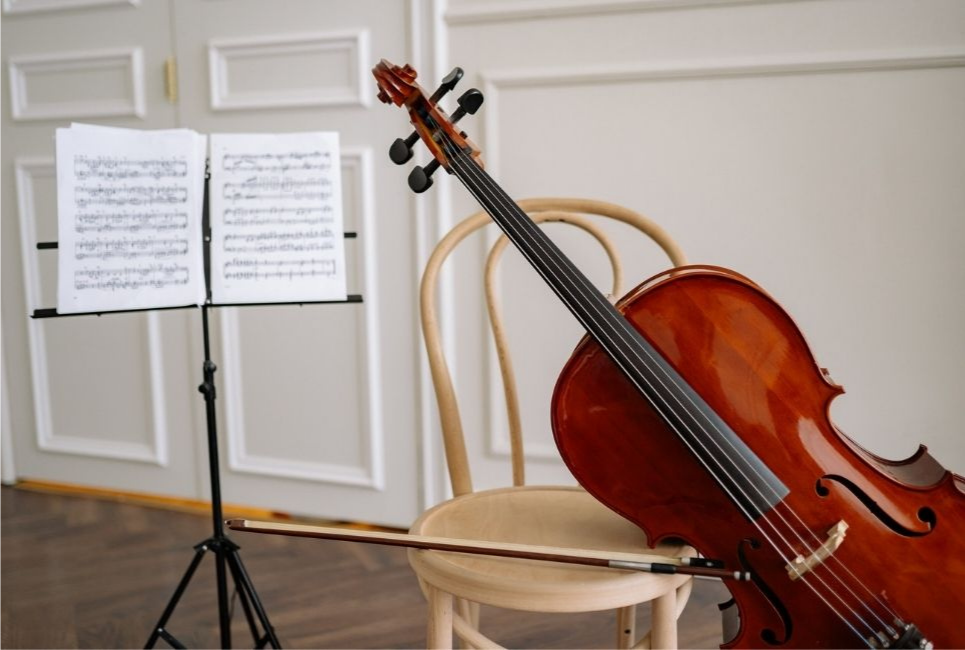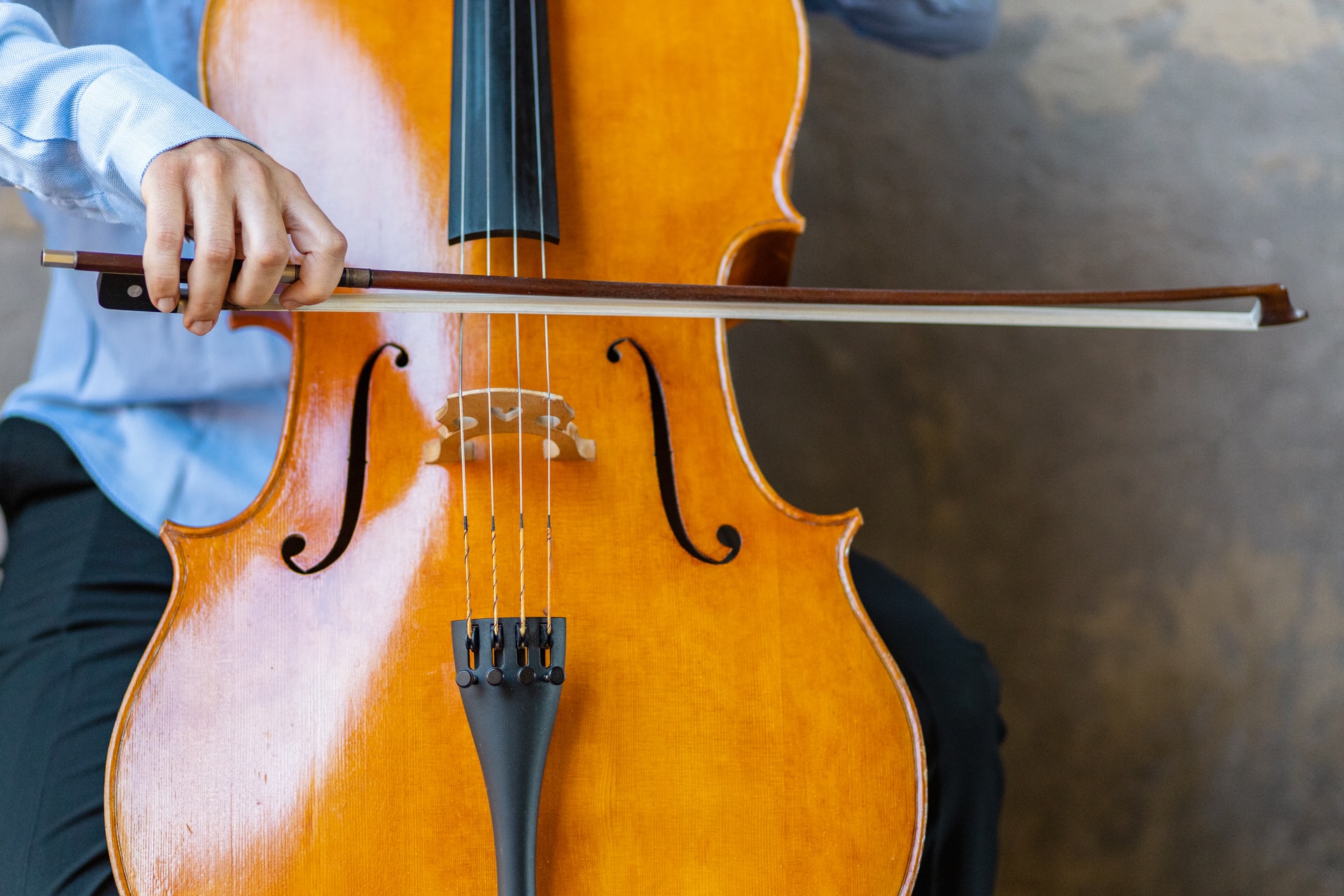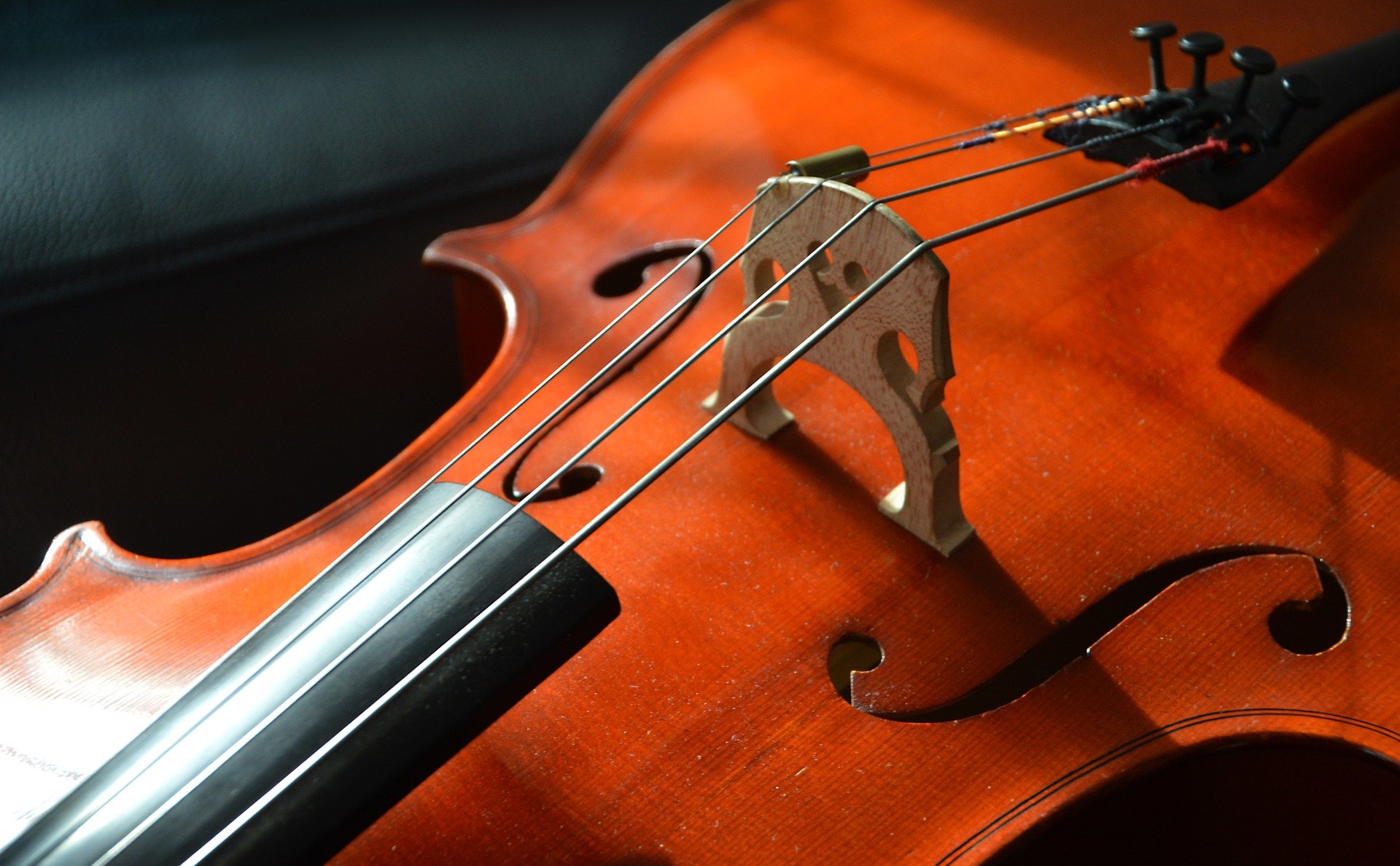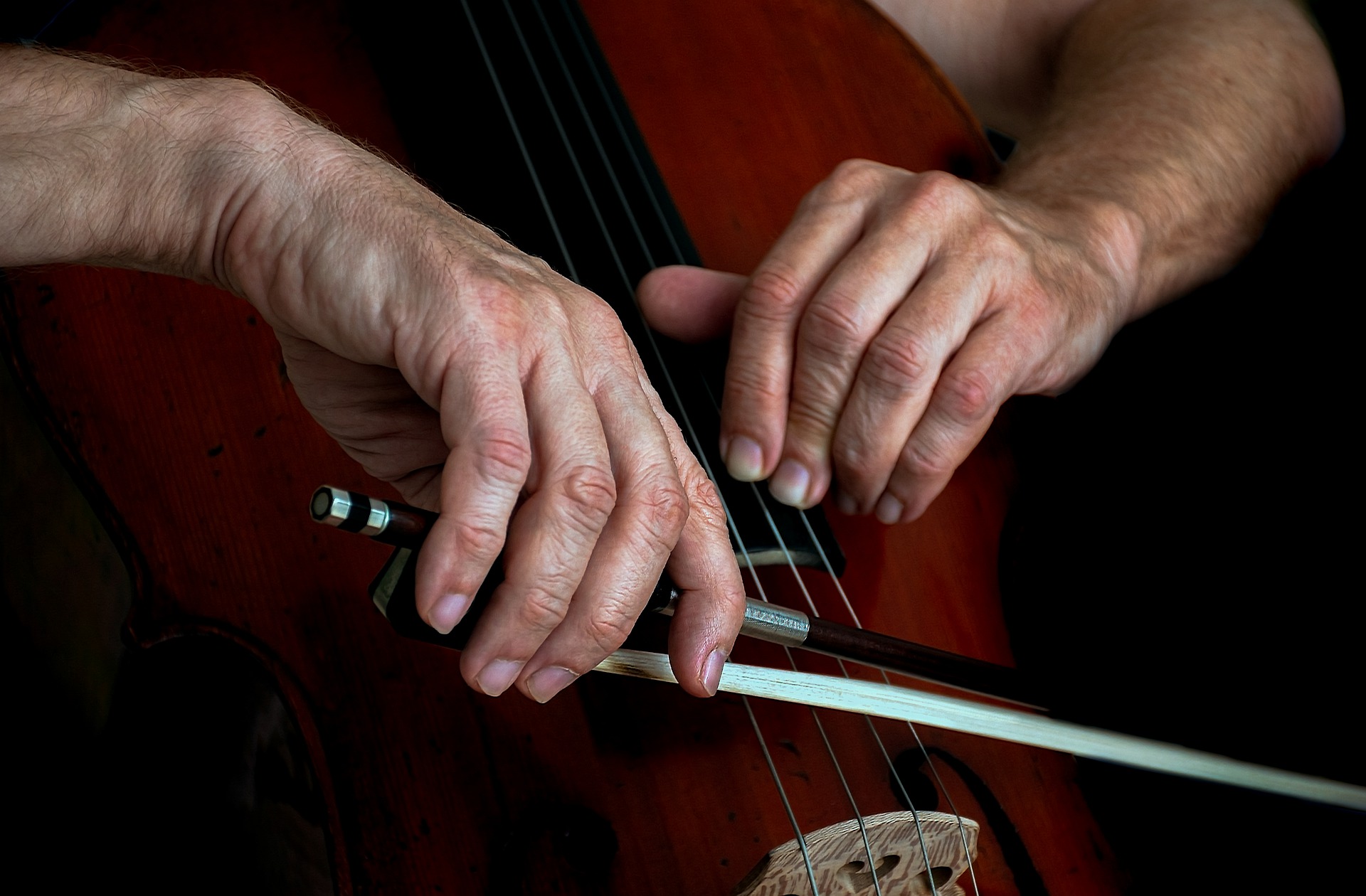- Cello Parts Guide: Everything a Cellist Should Know - November 1, 2021
The cello looks deceptively simple at first glance. But a closer study reveals the dozens of parts that work together to form the distinctive sound and look of the string family’s tenor.
Smaller only than the double bass, the cello’s size houses a complex system of acoustic shapers and other pieces meant to bring out the best in the instrument. Some are there to create or guide the soundwaves into tune; some to make it easier for the musician to play at their most natural posture. We’ll take you on a guide of the cello from the outside in to discover how its parts combine to form its unique whole.
Exterior Parts
We’ll start with a tour of the cello’s exterior parts. These pieces are what the musician interacts with to play and maintain the instrument. They probably look familiar if you’ve seen a cello performance.
The exterior components of a cello can be mapped into three sections, from the bottom up: the body, the neck, and the pegbox. We’ll explore each of these in turn.
Body
A cello is best recognized by the shape of its body in combination with its proportions. It is a distinct rounded, hollow oblong shape with indentations carved in the middle. It is a top generally made of spruce and a back usually made from maple. There are several different sizes of cello to accommodate different sizes and ages of players. Still, all sizes are built with the same proportions to preserve the same note range.
- Bouts: The inward curves of a cello’s side that seem to point to the f-holes are called bouts. Their position creates an easier path for the cello bow to move freely across the strings without bumping into the sides of the instrument.
- F Holes: Named for their letter shape, these hollows are carved on the cello’s top beside the bouts to create a way for the strings’ vibrations to bounce off the interior back and resonate to the top of the instrument. They are basically small acoustic amplifiers.
- Ribs: These are the sides of the cello, the external wood that connects the top to the back of the instrument. Their support is vital not only to the cello’s structural integrity, but also to its sound because they carry a lot of the physical resonance. The stronger the ribs, the better-sounding the cello.
- Purfling: Have you ever noticed that the wood bordering the top and back pieces of a cello is different from the rest of the body’s? That’s the purfling, which is used as a binding and prevents cracks in the instrument’s body.
- Bridge: It’s a piece of carved wood that stands parallel to the body and elevates the strings between the f-holes, supporting them and keeping them in the same tension as they run from the neck to the tailpiece. The bridge keeps the strings off the body so they have room to vibrate and their resonations are captured by the f-holes to be amplified. It’s not attached permanently to the body but is held in place only by the tensions of the strings, so the player must keep an eye on its position to make sure it stays in place.
- Endpin Rod: The cello’s body ends in a metal spike that projects from its bottom. It’s there to support the instrument as it sits upright at an angle in the playing position. The musician can adjust the height to their preference using the endpin screw placed next to it.
- Fine Tuners: At the end of the tailpiece, there is always at least one more tuning screw on the A string, and on some cellos there is one at the end of each string. These are the fine tuners, which are positioned as additional refinement for adjusting the strings’ tones through tension manipulation.
- Saddle: This piece of ebony wood sits in front of the endpin and spreads the strings’ tension as they terminate into the endpin. It’s meant to take some of the string tension pressure off the rest of the instrument’s body.
- Tailpiece: A cello’s strings end at the tailpiece, which sits near the bottom of the instrument’s front. The tailpiece contains holes to catch the end of the strings and the strings’ fine tuners.
- Tailgut: This is a nylon or metal string that connects the tailpiece and endpin rod.
Neck
A cello’s neck is the long thin piece of wood that comes out of the top of the body. It supports the fingerboard, and on the other end contains the pegboard and scroll. Usually crafted of maple, the neck’s surface has a slight curve so the strings are more accessible across the fingerboard.
- Strings: These are the long thin strings that run down the neck and the majority of the cello’s body. The player presses down on them and drags the bow across or uses their fingers to pluck them to produce the instrument’s sound. There are four, tuned at intervals of fifths using the notes C, G, D, and A. Although traditionally made of sheep intestines, cello strings are now usually made of tightly wound metal alloys.
- Nut: Located where the neck meets the pegboard, the nut is a small piece of wood raised perpendicular to the neck. It has four grooves carved into it that are meant to keep the strings organized as they go into the tuning pegs.
Pegbox
This is the section right above the cello’s neck. It houses the tuning pegs that each string is twisted around to get the proper tension for their individual note tones and spaces out the strings so they don’t get in each other’s way.
- Tuning Pegs: Each string wraps around one tuning peg at its end. To create a higher tone, the peg is twisted so the string tension is greater; to create a lower tone, the peg is twisted so the string tension is lessened.
- Scroll: The cello is topped off by this decorative swirl of wood. It doesn’t add to the sound or balance of the instrument, but it adds to the cello’s distinct air of elegance.
Interior Parts
A cello’s interior is where its unique sound is refined and perfected. These two parts are fixed inside a cello’s body and contribute to shaping the instrument’s tones.
- Sound Post: This wooden dowel internally bridges the back and top of the cello, supporting the body right underneath the bridge between the two F holes. It’s positioned there to amplify the vibrations made by the cello’s strings and resonate them through the instrument for a fuller, louder sound.
- Bass Bar: As the name implies, this part is used to amplify the lower register notes of the cello. The bass bar is situated in the instrument’s interior and is made of specially prepared spruce wood.
Accessories
Playing the cello requires a few things that aren’t attached to the instrument. Here’s what else a cellist needs.
- Bow: The vast majority of cello music requires this thin, tightly-strung wooden rod to draw across the strings and create their vibrations. There is a wide variety of cello bows meant for various preferences and playing needs, so finding the right one is crucial.
- Rosin: This wax is pulled across the hairs of a cello bow to help the bowstring grip the instrument’s strings for sound production. Again, the type used is largely up to the individual player, but all cellists need it to get music out of their instrument.
- Endpin Strap or Stop: These are optional but useful accessories, especially if you practice on surfaces that are not only used for cellos. An endpin strap harnesses the bottom of a cello’s endpin to something like a chair leg, and a stop provides a grippy ground rest for the endpin. Both are used to anchor the cello’s endpin better to a floor; the strap is good for steadying on fluffier surfaces like carpet. The stop is good for protecting hard surfaces like wooden floors that the endpin may scratch up if used alone on them.
- Cello Mute: Another accessory that isn’t vital but can be very helpful is a piece of rubber or metal that fits against the cello’s bridge and lowers the instrument’s volume by damping the strings’ lower vibrations. If a cellist needs to practice in an area crowded with other people who would not appreciate the noise, it can be a lifesaver.
Frequently Asked Questions
Answer: Although the cello may look sturdy because of its size, all of its parts must be in top condition for the instrument to work. All require a degree of maintenance for proper cello care. That being said, there are two parts in particular that a player should keep an eye on and check every time the cello is going to be used.
First, the bridge is the only piece of a cello that is not secured onto the body by physical adhesives of any kind. It’s held onto the body, perpendicular to the top’s plane between the f-holes, by the sheer force of string pressure alone. That means it’s especially prone to leaning one way or another, which detracts from both the usability and sound of the instrument. Beginning cellists should make sure their bridge is inserted and adjusted by a professional for their first few forays into playing, and then under supervision for a few more. Inexperienced handling can break or warp the bridge if not corrected immediately.
A cello player should also take great care in handling their instrument’s strings. Since these are tuned at least once each playing session and often from two places (the tuning pegs and the fine tuners), they receive constant tension changes and stresses. That makes them prone to breakage, and players should always have spares on hand for these occasions. This is another thing that an inexperienced player should get help with until they are confident in their own abilities so they don’t cause more breakages than necessary.
Answer: Each individual cello part we discuss in this article can be found on one of three sections of a cello. Its pegboard tops the instrument when it stands upright, with the neck directly below and the body below the neck.
Answer: The cello is very similar to its stringed relatives. Violins, violas, and double basses all have the same general construction. Their pegboards, necks, and bodies are the same shapes. Each instrument is made from the same staple materials. Each utilizes four strings stretched taut down their necks and bodies to play with a detached bow. Even the rounded corners, c-shaped middle indentions, and f-holes of the cello are placed almost exactly as they are on the other stringed instruments. Most of their differences are a matter of size. Also, the string instruments that are placed on the shoulder to play (the violin and viola) have chin rests instead of tailpieces and tailguts to accommodate their different playing style.
Answer: Cellos of all qualities are going to consist of the same parts. That being said, the difference between quality of parts can make or break a player’s relationship with the instrument. Cellos that have fine tuners on all strings, instead of just the A, will be able to refine their strings’ pitches in more nuanced intervals; cello bodies and necks crafted of traditional treated woods such as spruce and maple with ebony accents create richer sounds than those instruments made of fiberglass and plastic. Many aspiring cellists start with less expensive instruments until they know for sure they would like to continue playing indefinitely. Still, some prefer to start with the highest quality they can afford to make sure their learning experience goes as smoothly as possible. In the end, it’s all up to the player; after all, they’re the most important part of whatever cello they choose to use.
Final Thoughts
Every part of a cello contributes to its unique, beloved sound. When a player knows how this happens, they can take full advantage of all their instrument can do. Becoming familiar with all the pieces of the instrument also keeps the musician in tune with early warning signs of things that may need adjusting so they can be fixed as soon as they come up. In short, the parts of a cello are important to understanding and maintaining the long tradition of the string section’s backbone.
For more interesting readings check out:




